Transcript:
This conversation has been lightly edited for clarity.
[Preston] Welcome back to the Gentleman’s Gazette. We are here in Stockholm, Sweden, at A. Marchesan. This is Alexander. Thank you for having us.
[Alexander] Thank you. You’re welcome to be here.
[Preston] Very good! So, tell us a little bit about the store. First of all, how long has it been here?
[Alexander] Well, at this location, we’ve only been for two years. But, the store, I started the store originally in 2008, I think, or nine. So, around 15 years ago. But, I started at another location, small location. As you normally do, you open small scale and then expand. So, I had this very small store, I moved to another place, a temporary place, and then I moved to a larger store 300 meters away from this store. And we opened a store similar to this one, and we were open for five or six years, and then we had to close and move from that location, and we moved to this location. So, now, hopefully. we will stay here forever.
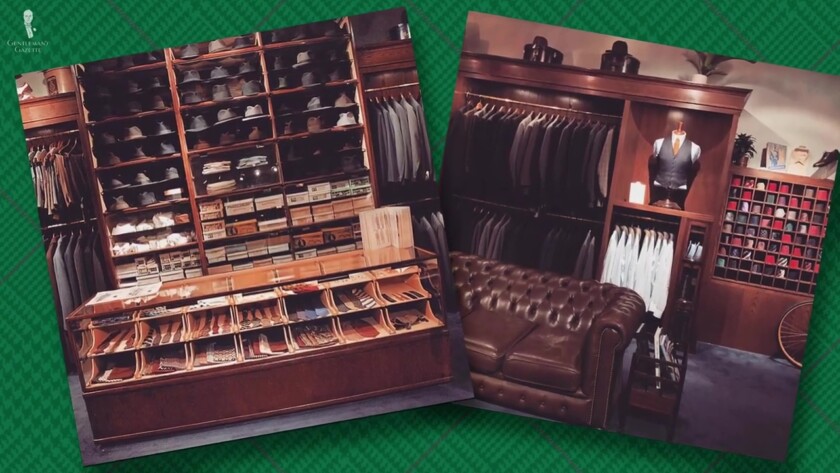
[Preston] Good, good. So, you’re enjoying this space?
[Alexander] Yeah, really. This is the best; by far, the best location so far.
[Preston] Very good, very good. So, in addition to the physical location itself, are there other ways in which your store has changed over the time that it has been open?
[Alexander] Not that much to be honest. Because I had… Before I opened the store, I had this picture in my head, how I wanted it to be. But, of course, you cannot… You have to start here, and you go like this and maybe you will reach your goal, but you cannot go instantly from here to there, so…
[Preston] One step at a time.
[Alexander] Exactly so. But I had this—what do you call it—this vision in my head, and that vision was very close to what you’re seeing now; and then, of course, over the years, I had… You get new ideas all the time. But, I’ve kept very close to this original idea, I would say actually.
“I had this vision in my head, and that vision was very close to what you’re seeing now.”
Alexander Marchesan
[Preston] So, your vision has been realized, you would say?
[Alexander] Yeah, I would say. It took a few years, but I would explain it that way.
[Preston] Very good, very good. So, even before the store opened, what inspired you to get into the vintage clothing business?
[Alexander] Well, first of all, of course, I was… Vintage clothing has been an interest. I was a collector of vintage menswear. I used vintage menswear daily. So, it was a hobby that developed into a business. So, I didn’t start the business and then became interested in vintage clothing. I don’t think that, that’s not how it works because…
[Preston] Not typically, no.
[Alexander] No, you will not. This is not… If you’re aiming to be a, like, dollar millionaire, you will not be working with the old, vintage menswear, I can tell you. So, you have to have the interest and the passion for it.
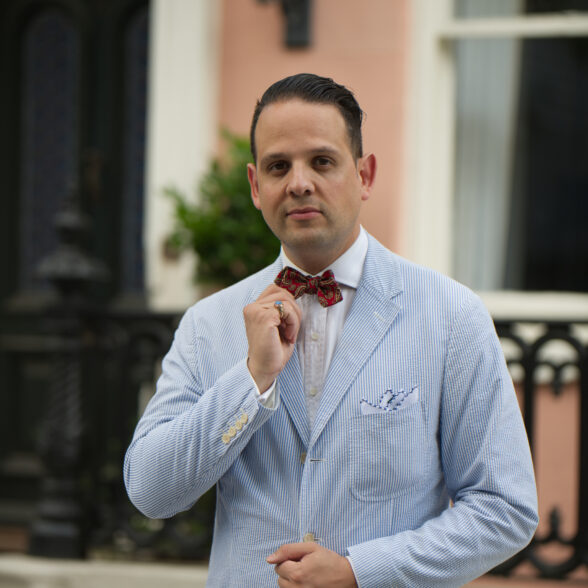
Alexander started with passion
Just like Raphael did!
[Preston] That is certainly understandable about it beginning as a passion for you and then becoming a business at a certain point afterward. Much the same was actually true of the founder of the Gentleman’s Gazette, Raphael Schneider. Classic menswear started as a hobby for him, and then matured into the business that you see here for us. So, sort of a similar pathway, perhaps. To inquire a little bit more about the vintage clothing itself, how do you go about finding the stock for your store?
[Alexander] Well, of course. it’s difficult because there’s only a certain number of garments around as we only sell clothes… Most of the clothes we sell are Swedish-made and 60s, 1960s, or earlier. And so, it’s… I like to compare it with, like, the sea. There’s not… There has been too much fishing going on, so nowadays, you don’t get anything at all when you’re—what do you call it, like this?
[Preston] Casting your line out?
[Alexander] Yeah, it’s getting much more difficult to find but, over the years, we have positioned ourselves on the market so people know about us. And these two things, that’s a balance. It’s getting harder to find stuff, but a lot of things will come to us. In a way that it didn’t from the beginning. So, at this point, we have no problem really but, of course, in the future, sooner or later, it will be very difficult to find clothes from 30s, 40s, or even older.
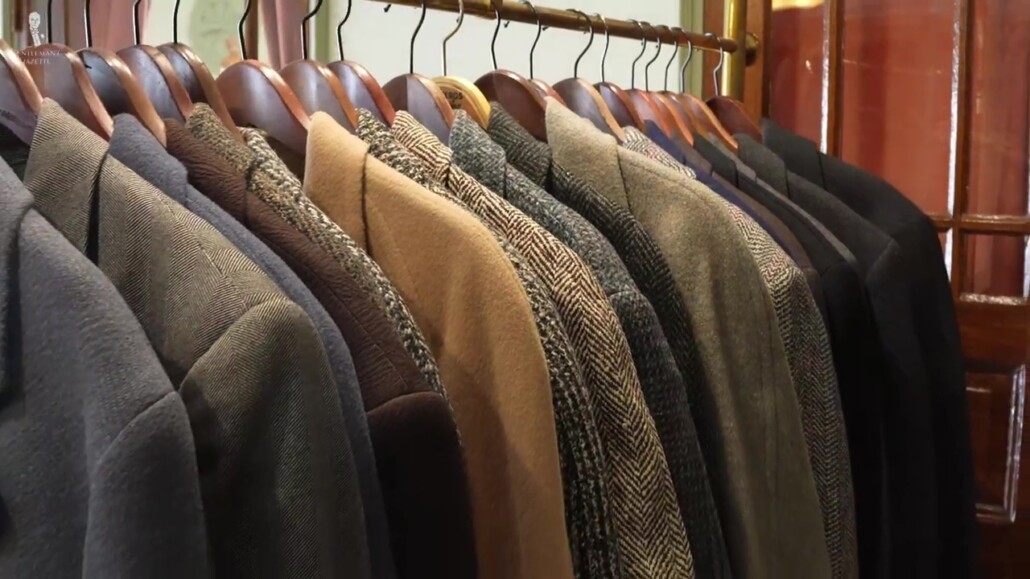
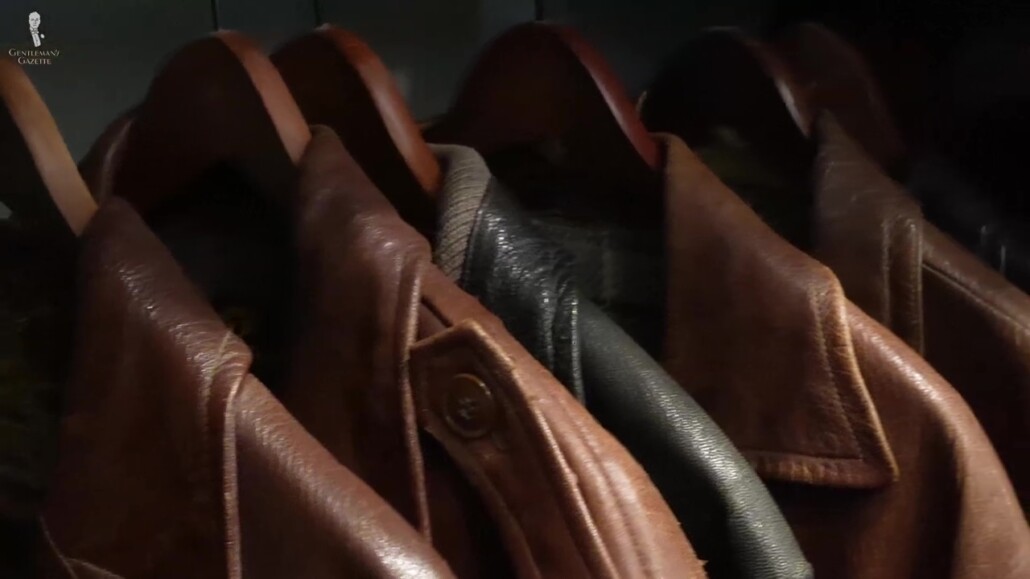
[Preston] Right, with limited quantities, but I can see how perhaps, if there is a sale of certain vintage pieces from an estate or something, and they’re floating around the marketplace, now that you have gotten your name out there and the name of your store out there, somebody might see, “Oh! There’s a vintage piece. I wonder if they might want it for the store,” and they’ll get in contact with you and set it up from there, I would imagine.
[Alexander] Yeah, yeah, exactly. And I should also mention that, of course, the value of the clothing nowadays is very different from 10 or 15 years ago. They are valued much higher, so that means maybe we don’t have to sell the same quantity, and that’s good because we don’t you cannot have enormous quantities of these pieces. It’s impossible.
We love the charm of vintage! Check out 14 of our best finds!
[Preston] Right, right. Yes, that’s very good. Well, to that point then, or, I guess, to flip that on its head, what would you say, these days, is the most challenging aspect of selling vintage clothing? Is it the limited quantities in general or would it be something else perhaps?
[Alexander] Well, for us, it is. I would say… But, it depends on what you… I mean, I have my own idea about what’s vintage clothing. I would never consider like 1990s clothing as vintage, but there are people there are businesses that call themselves vintage, and they have nothing that is older than like 25 years, and I guess for them, it’s not a problem because there’s enormous amounts or quantities of clothing from the ’90s. But, for us, it’s a problem for the obvious reasons that I mentioned before. So, I think that’s the the main thing because people are getting more and more aware of the differences of the qualities if you compare back then with now.

Alexander doesn’t have problems
Finding people buying vintage
“We find new customers all the time, so that’s not the problem. The problem is to find the clothes that they want to buy.”
[Preston] Right, that makes sense. What, then, would you say is the most challenging aspect of selling the clothing? You’ve said that you don’t have trouble finding customers, which is certainly a good thing, but what’s challenging about making the sale, perhaps?
[Alexander] Well, as always, when dealing with secondhand or vintage clothing, we only have one of each piece. That’s the main problem. I cannot… Sometimes, we have a suit that I know we could sell like a hundred of it—hundreds, maybe—but we only have one, and when it’s gone, it’s gone. We’ll never see it again because maybe it was bespoke. Yeah, so that’s, you know… We also sell… Over the years, we have started selling a few new things also, like socks and so on, and that was when we started with shirts for a few years ago. And that was, for me, it was something completely new. [Someone] wants to order ten shirts. No problem, I can get ten shirts for him. But, because I had never experienced that before, I have only been dealing with the vintage clothing. And I was used to only having one of each piece.

[Preston] Right, the benefits of having your own line, I suppose.
[Alexander] Yeah, that’s…. Exactly, that’s what it’s all about because we started… The thing is I don’t think we will ever produce something new that is, that we can easily find vintage. But, there are some things that are very hard to find vintage, and they are they are sought after. There are a lot of people who want to buy them. Like knitwear, for instance—it’s very hard to find in good condition—and shirts, same thing. That’s why we started with shirts because we had like, if you start from the top, we had hats—in hundreds of like 30s, 40s hats. We had suits, shoes from the same era, but no shirt because it’s so hard to find. Of course, you can find a dead stock shirt every now and then, but you cannot have a line of dead stock shirts in all sizes. It’s impossible. So, we got that situation because, a lot of uh customers coming here, they want; maybe they’re going to a wedding, for instance, they want to buy everything from top to bottom if they can, and then we could not provide the shirt. That was the problem. So, that’s why we started producing shirts so I see that our new products, they are… It’s like—I don’t know if you could say so in English—but not compliment….
[Preston] Yes, it’s complimentary.

[Alexander] Complimentary, yes. Yeah, exactly. So it’s not supposed to take over or so, and we will not take away our vintage selection because of producing new stuff.
[Preston] It doesn’t—to relate it to the earlier point—it doesn’t detract from your vision. It just supplements to allow the customer to have a more complete package.
[Alexander] That’s exactly how it’s meant.
[Preston] Yeah, so for those pieces that are in your own line, how long does the process take from the initial idea that you have of, say, “We’re going to make a shirt,” to having a finished shirt in store for the customer to buy?
[Alexander] Well, taking shirts as an example then; it won’t take too long, but if we talk about, like, knitwear that we’re doing right now, it’s a different thing. It, I would say, takes probably too long. But I haven’t done this for all my life. So, I mean, I know how I wanted it to look, I know nothing about the production of…

[Preston] Manufacturing.
[Alexander] Exactly, that’s… I have never worked on that, really. So, I think, for me, it’s very… And I’m a perfectionist. Maybe, sometimes, too much. But, it’s not a choice. It’s like how you’re…
[Preston] How you’re wired, so to speak.
[Alexander] Exactly, but I think the important thing is to come out at the right place, not exactly how long time it takes to come to get there. But, of course, I also realize if a person with more, like, an economical mind wouldn’t agree because that’s not how it’s supposed to work, I guess. But, for me, it’s important. I want that if we take like something like this, for instance, I want the final result exactly as I planned for and that’s the important thing—not that we can release it like this month or next month. But, of course, sooner or later, we have to release it, otherwise, there is no point.
[Preston] Balancing the needs of… doing it fast but also doing it right.
[Alexander] Yeah, I would say. Like to point out one thing also, when dealing with vintage clothing, you have this idea about, you want to create something that will go well with the vintage clothing. You have also this problem that you cannot take any… you have to find the best you can—the best buttons you can get, the best place for the knitting, the best producer—because, otherwise, the general quality of the vintage clothing is so high.
Want to incorporate timeless style into your wardrobe?
[Preston] So, you want to meet that same standard.
[Alexander] Exactly, as much as possible. Sometimes, it might even not be possible. But, we cannot just create something that is okay but not more. You see what I mean? It has to be the best of the best. And also, of course, you also have this problem that… I mean, a lot of these old suits, there’s a lot of hand stitching and so on, so you could get that today also, but it’s a matter of price. We’re not doing bespoke, we’re doing like ready-to-wear clothing. And it cannot cost…
[Preston] A fortune.
[Alexander] No, exactly. But something that everyone in the business is aware about, of course.
[Preston] Right, it comes back to that idea of it being a balance, you know—how much quality can be represented in a price that you think you can sell it for.
[Alexander] Yeah, I think, for instance, I think we would it would be very difficult for us to reproduce, like, complete suits or complete sets like three-piece suits. I have seen… I know there are a lot of companies doing reproductions. I haven’t seen any yet that I would say it’s comparable to a real vintage suit, and it’s not only… It’s also it’s not only about what I think; the thing is that our customers are very aware, and, of course, I would never…

business ethics 101
Honesty and transparency
“When you run a business like this, you develop a very special bound to your customers, so I would never take a piece that I don’t think is top notch myself and, like, telling the buyer this is the greatest suit on Earth. I wouldn’t do so.”
[Alexander] So, I have to feel. I have to. Yeah, you understand.
[Preston] Yes, so you’ve mentioned the shirts that you produce, also, we’ve been talking about the knitwear as well, anything else in the works? What’s next for you in terms of what you’re producing
[Alexander] We have a few other projects going on. We’re doing a Balmoral boot. Actually. I’m wearing a sample right now.
[Preston] Very nice.
[Alexander] But, this is only a tester, a sample that we made in goat skin. And we’re not sure, we will probably use kangaroo leather actually. But, this pair of shoes is in goat skin. So, we wanted to… because a lot there are a lot of—at least in Sweden—I would say, the main part of the shoe production in the 1910s, 1920s were goat skin. They used goat skin leather for these kind of boots. It’s very… you don’t see it today so much. So, we wanted to make a sample and evaluate it. So, that’s quite a large project that we have going on, and I don’t know. We get questions all the time, when… There’s a lot of people waiting for them. “When can we buy them?” And I can’t give a 100% correct answer, but as soon as possible, that’s my best answer.
Red Wing Boots: Are They Worth It?
[Preston] All in good time. And what drew you to kangaroo leather?
[Alexander] That was only by chance because the guy we’re working with had knowledge about kangaroo leather because I never had kangaroo leather shoes before. But, it turns out kangaroo is very strong and you can make the leather very thin. So, you get this… almost the feeling like it would fit like a glove around the foot. And we have made the samples in kangaroo, and I have used them myself for six months now or so. And so, I know how it…
[Preston] How it wears? How it feels?
[Alexander] Exactly, exactly. It’s extremely soft, so there’s no, you know… a lot of quality shoe producers that you have to walk the shoes like for one month before you know how they would really feel in the end. But these are very soft from the beginning. So, the best way of describing is “like a glove.”
[Preston] Very good, very good.
[Alexander] So, that’s a large project. And then we also have a smaller one. We were doing spats. And that’s just a thing because I don’t expect to sell like millions of spats. That would probably not happen, so that’s more for fun, I would say, because it’s very hard to find.
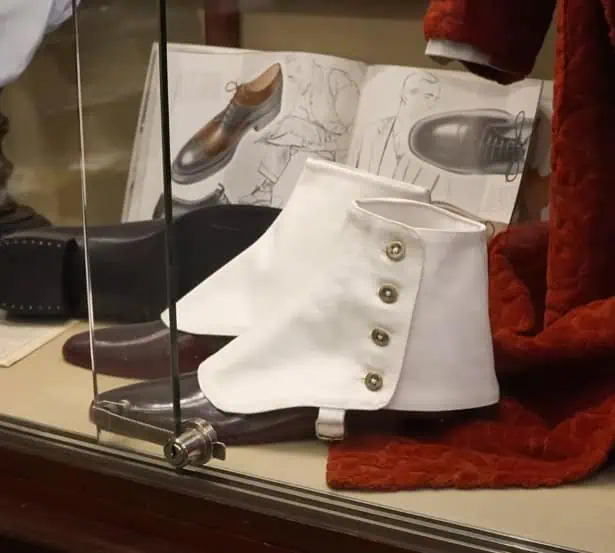
A. MARCHESAN’S SMALL PROJECT
Spats
“I have been using spats a lot on my own. I have a lot of spats in my own wardrobe. But, you know, you don’t see them a lot. Let’s say, we are like three persons in the whole city of Stockholm wearing spats, probably.”
[Preston] Only those in the know.
[Alexander] Yes, yeah. But, it’s very hard to find the larger sizes, that’s the thing. We we get people here every now and then, asking for spats. But, usually, no, we can’t provide them with spats because we only have like very small sizes, and the old spats were also made for very slim shoes. That’s also a problem today. People are wearing much…
[Preston] On average, people’s feet are larger now than years ago.
[Alexander] Yeah, there’s a lot of things to think about.
[Preston] So, we know where you’re at, currently, in terms of what you’re working on and how things have gone, where you’ve come from. But, looking ahead to the future, what would you say the plan is for the store in the next few years or perhaps beyond?
[Alexander] Well, I think the key is to go online because we’re building, we have been working…
“I’ve said for like ten years, people make fun of me because of this, I’ve said for ten years that we are going online soon.”
Alexander Marchesan
And so, it’s almost like a joke, but we’re, in fact, we’re working with it right now, since three months. We are two people working on it every day. But, it’s a lot of work and, I mentioned before, I’m a perfectionist and that goes only not with the clothing we sell but also this website. And I want it to be a very serious website. But, we are progressing all the time, so I think that’s the key because we will reach… Wait, a minute there.
[Preston] Oh, yes, there’s a moth.
[Alexander] This is not good. You don’t want it in the… No.
[Preston] The dreaded enemy of any clothing.
[Alexander] Yeah. I mean, this store is very specific. It’s not, this store is not for everyone. This is something I realized very early in the progress of developing the store; because if you want to create something for everyone, you cannot be very specific, if you know what I mean.
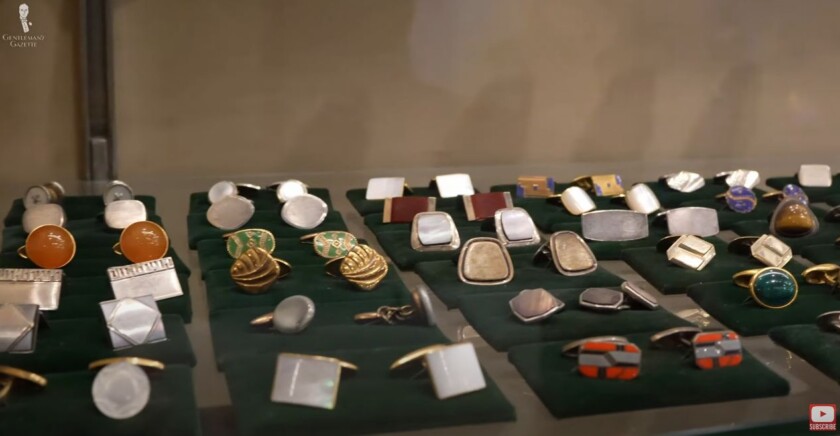

[Preston] Right, you have to be very general in order to be all things to all people. But to cater to a more specific clientele, it’s different.
[Alexander] And you can just take a look in the store and you will immediately realize, no, this is not for everyone. This is for people that are very interested in clothing. And, of course, the physical store here in Stockholm, we can only reach, I don’t know, 2% of the people now; probably even less than 1% of the people worldwide that are interested in this. So, of course, we have to be online so we can reach everyone else for everyone’s—how do you say…
[Preston] For everyone’s purposes.
[Alexander] Yeah. So, that’s one key and the other key is, I think, that we should continue developing our own…
[Preston] Your own range of products.
[Alexander] Exactly.
[Preston] Great! So, in addition to working on the website, how else can can people online find you who are interested? Can they find you on, say, social media, for instance?
[Alexander] At the moment, I would say Instagram is the best. We have had our Instagram account for many years. If you follow our Instagram account, you will be updated regarding the coming web store and everything else that matters around the store, so that’s the best way. And then, when we are online, of course, the website will be a good way, and I guess we will have a newsletter and so on. But, at the moment, I would say, we were also on Facebook, but Instagram is much better, and Instagram is in English. Facebook in Swedish, for us.

[Preston] So, to bring the video to a close, as our longtime viewers know, we typically give an outfit rundown of what the host is wearing, but to change things up today, would you maybe walk us through the outfit that you’re currently wearing? All of the different pieces?
[Alexander] Sure, most of it, well, obviously, it’s from our store. So, first, you have these sample shoes that are a reproduction. It’s not a copy of a 1920s, 30s shoe. It’s inspired off a 1920s shoe, and it has the details that we think that Balmoral boots had back then and similar boots don’t have today. So, well, I usually wear Pantherella socks because I think they’re nice quality, and we sell them also. The trousers are like standard… It’s part of a suit, a two-piece suit, a Swedish 1950s; and then, you have this cardigan that we’re developing right now—we will be. This is one of the colors, cream, and we will also have a beige and a green one—like dark green. So, we will begin with four different colors, and they will be available online as soon as the online store is up and running. What else? the shirt—that’s also one of our shirts that we produce in Italy.
[Preston] Very nice Winchester style with the contrasting collar and cuffs.
[Alexander] It’s a Swedish vintage tie. What else? I don’t know.
[Preston] Well, you’ve got your ring, your watch.
What Rings Mean on Each Finger?
[Alexander] You’re right. I have these cufflinks. I like these—what do you call them in English?
[Preston] Mother of pearl?
[Alexander] No, they open like this.
[Preston] Oh, a snap cuff!
[Alexander] Snap! Yeah, exactly, snap cuffs! I wear them a lot and I really I don’t understand why they are not produced anymore or more common today. It’s so easy, and they are double-sided and very easy to open. So, I wear cufflinks almost every day, and usually only snap links. The watch, that’s a 1954 Jaeger-LeCoultre automatic watch. It’s called the Futurematic. That could all?
[Preston] Your hat?

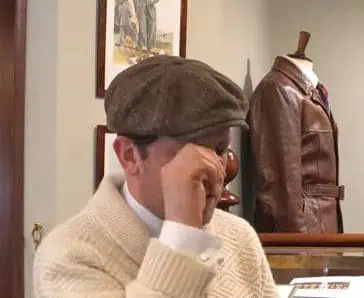
Tweed hat
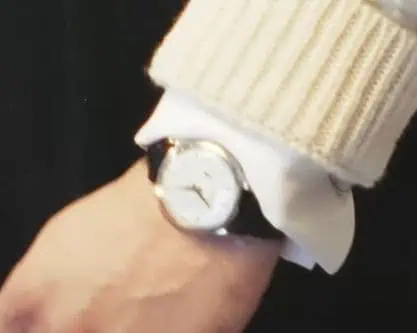
1954 Jaeger-LeCoultre automatic watch

Swedish vintage tie
[Alexander] This one is actually from our neighbor store called Tweed. So, we are like brothers, or how would you explain? We are, like, 50 meters away from each other, and we know each other very well since many years. And we have some similar clients or customers, but not all the way. We have some specific clients, and they have some specific, but they go like sometimes like this.
[Preston] Yes. Yeah, sure. Great! Well. thank you, again, so much for having us today.
[Alexander] You’re welcome! Nice meeting you!
[Preston] Yes, you as well! Look out for everything else the store has planned in the future when the website gets up and running and rolled out. And yeah, we look forward to seeing what’s in store in the future as well.
[Alexander] Yeah, and keep an eye on our Instagram account.

Second hand tat from overseas. This site is sinking lower and lower.
There is no reason to be rude, and it’s ungentlemanly. If any video is not to your taste, you are not required to watch it or enjoy it.
I found it very interesting to see that there are people who care about quality clothes and would like others to have the opportunity to enjoy them as well.
Appreciate the support, as always, Randall. Lovely to hear you found the interview interesting, too.
Thank you for an interesting and inspiring article about a venture with an historically relevant purpose. Read in conjunction with the article on Scandinavian style it provides a window to broaden what might be the myopic view of some.
Interesting video.
I have never bought used clothing or a watch in my life. I could never understand why someone who couldn’t’ afford an item would buy second hand. When I bought my first stainless steel DateJust Rolex, I bought it on lay-away. It took some time for me to pay it off but when I did, it was mine, not some else’s that I bought used. I have always thought people who buy used items are just poseurs,
I hope that Mr. Marchesan does well with his business.